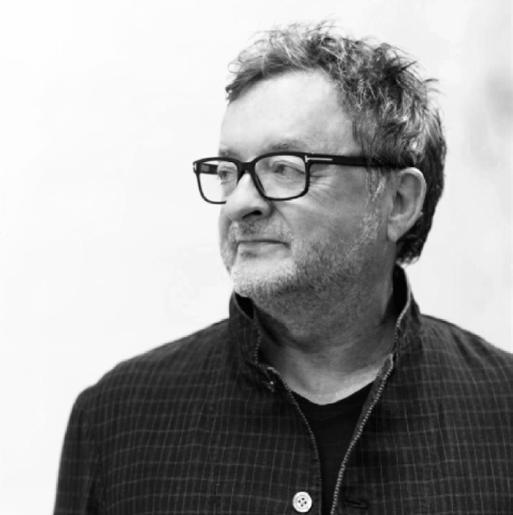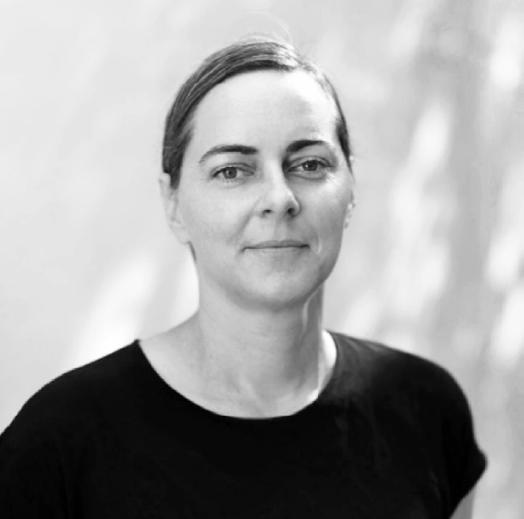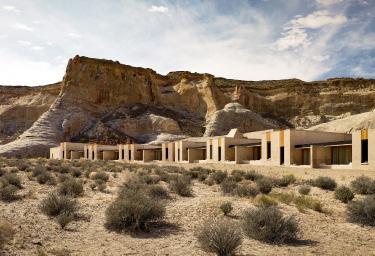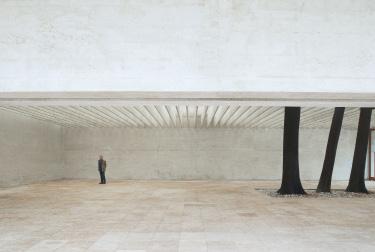
14 minute read
with Erin Bascom Rick Joy & Claudia Kappl Joy
Rick Joy & Claudia Kappl-Joy a conversation with Erin Bascom
Rick Joy is the founder and principal of Studio Rick Joy. Originally from Maine, he studied music and was a classical percussionist and rock/blues drummer until the age of 28 when he moved to Tucson to study Architecture. Now, he is considered an important contributor to the ongoing global discourse on conceptual and sustainable architecture. HIs work expresses innovation and exactitude in modernism and reflects a unique sense of place. Rick has won numerous awards and serves as a visiting professor at several prestigious universities.
Claudia Kappl Joy is the partner of Rick Joy and has been a collaborator to the SRJ team for over 13 years. In 2013, Rick and Cluadia co-founded the lighting design consultancy studio, CLL - Concept Lighting Lab, LLC, in which she is creative and managing director, leading all projects - responsible through implementation - having done so on several award-winning projects. Cluadia has lived and worked in Austria, the United Kingdom, Sweden, and since 2007, has called Tucson home. Claudia’s fascination with the ephemeral quality of light and its essential role when creating moving atmospheric space is at the base of her design approach and interest.

Erin Bascom: How do our buildings connect with each other, connect with their environments, connect with us, and connect us to each other?
Rick Joy: Never thought about that before, did you?
Claudia Cappl: Every building, every project you do is grounded in context and place and that’s how it connects to the environment, as well as the building cultural place.
R: I mean I generally like to connect things in a way with nature and emotion and atmosphere. I think building culture plays to people, the families, the environment and the actual culture. All can connect and we have to try to do that as well.
E: Yes, What strikes me about your work is how your buildings connect with local culture and place in a way that is stronger than other architects. It seems to guide your work, this connection, no?
R: Well, I definitely believe in a very localized cultural relationship and building culture and people. I also appreciate people who view the planet as the local like Zaha Hadid but I’m just more drawn to the actual real place we’re building in. With Amangiri we were very
To go back to Zaha Hadid and other architects that take more of a global approach to architecture, why have you personally been drawn to more of a regional approach, and do you think that is in any way superior to the global approach? intentional and instead of building a place that appropriates the imagery and cultural relics of the indigenous Navajo, we refocused the endeavor on resonating with the landscape and the place with an acknowledgement of its history and culture. That in itself is a way to reprogram culture and society. It may seem subtle but in the architectural landscape it creates a wave. It also has to do with looks a little bit, but it also has to do with caring a lot about how people might feel or live in the place. When you go to Princeton it’s an academic Gothic campus and they have recreated historical Gothic ‘stuff’ so when we got our transit hall project there, we tried to resonate with that campus Gothic. But we did it in our own way, in a new way - the columns are all stacked very much like the cathedral city and we just let the height and the reach guide the mantra for shaping. “Every building, every project you do is grounded in context and place and that’s how it connects to the environment, as well as the building cultural place.”
R: Well, I don’t think of anything as superior, but I do think that I personally resonate more with being up close and personal with place and if we ever get commissioned to do an Olympic swimming pool in France, you know okay that could be a standalone object building that’s globally oriented.
We touched on indigenous culture and the historic mistreatment of these populations, I think that’s a really relevant conversation given the current social climate and happenings of the past year. Do you think it is the role of the architect to look critically at our practice and how we can make reconciliations?
R: I do support the current movements towards a more equal society on all levels but I don’t want to get into telling people how to make reconciliations because it’s too complex and sensitive of a subject to just take a simple stance.
E: I believe to take a stance on the matter, instead of disregarding it, is maybe how we start making progress in some of these areas. As a country, we’ve been recognizing this the past year. Do you have any thoughts on that? R: I think the point is to keep your eyes open at all times and try to find poignant connections that mean something, and so in our work, for example, we did this hacienda in Taos, New Mexico about a mile from the Taos pueblo and we made it out of earth in a modern way. So, there’s lots of different ways to be sustainable and also not just give money to charities but to think of ways to help and be creative on all levels in education.
E: I agree, education is important. I think one of the best things we can do is make sure we’re involving multiple perspectives in these conversations and holding space in our work and discipline. R: It’s a tricky thing to just create a big charity kind of thing and make new houses and everything and also make it sustainable and fully encompassing. It’s not easy emotionally and spiritually for any of us to receive something like that, so it just takes time.
Continuing with Rick’s thoughts on connection to place, context, nature and regionalism, can you discuss the role of lighting design within that including the locality of light and connection.
C: It plays a big role dependent on which environment you are working in. So in our studio we approach lighting holistically - meaning when we look at what the day lighting does, what the environmental conditions are, and then we respond to it with the electric lighting to balance lighting needs. And that condition changes anywhere and everywhere. If you’re in a northern or very southern latitude where the sun is mobilizing beyond the horizon or is very low in the atmosphere, we have a
C: If it is about authenticity, then you take an artificial environment like Vegas and every aspect of it is artificially introduced, but then, in itself, it is a fantastical authenticity of man made environments, and it is incredibly convincing. So, is that more fake just because it happens to be a strong concept followed through very, very, well? I wouldn’t want to judge it but I’m saying it’s very authentic to what Vegas wants to be. Whereas, if you go to experience a simulated environment in a Japanese tea ceremony it will be a very authentic environment so all have their appeal and truthfulness.
R: I think lighting has a very unique opportunity to really be very personal. very different condition for lower intensities of daylight, whereas if you were on the equator that’s reversed, the sun is very high above us and it has huge implications on the building, the envelopes, the fenestrations and how that is then expressed in the facades and in the in the living conditions or the lifestyle concept and then how that makes its way into opportunities of lighting is very much dependent on how you live on the land to not just culturally but topology wise.
What do you believe in regards to the honesty of lighting design in connection to our contexts? For example, the Nordic Pavilion at the Venice Biennale used lighting strategies to mimic Nordic lighting qualities, and so I think that’s something really powerful, but obviously it is kind of a replication of that experience but in Venice. Do you think we should be more honest with our lighting strategies and try to connect us to the place that we’re in or is there a place to create these false atmospheres?
C: We all have a very subjective way of seeing and reading light. It connects to memory and connects to our emotions. And, in this very personal way the same light conditioning may bring about very different feelings for different people. Perhaps the most powerful thing that lighting does is it allows you to transcend something that is present. It’s very powerful in storytelling, in creating and connecting you to your emotions and transcending the very present into something else. That creates connections on different levels that might not be manifest as architecture is very much in a place at a time.
R: With the Nordic Pavilion, he (Sverre Fehn) asked to come to Venice and build something that represents Nordic lands right? And so, he chose to bring the light and I think some other country might make a Roman Chapel mini one or something that’s fake but this was bringing the emotional life experience from the Nordic lands from the north, which is a pretty profound experience. I think it’s brilliant and I wish I did it.
E: It’s an incredible project, and I think the ability, like you said, of that project to connect us with something that isn’t there and the capacity of lighting design to connect us with us to transcend the things that aren’t inherently architectural is the most profound.

Amangiri Resort and Spa in Utah by SRJ Image by Joe Fletcher via SRJ

Nordic Pavilion in Venice by Sverre Fehn Image by Åke E:son Lindman via Archdaily
R: I overheard people saying, “Wow! I need to go to Finland, I need to go to Norway and Sweden to see that light.” And it’s a brilliant project you included and nailed it with your answer- it’s emotion and memory recollection. I could still feel it.
Here, we are recognizing the most significant thing about architecture is its ability to connect us with those emotions and memories. Have the events of the past year changed your outlook on design work? For example, many of our public buildings have become obsolete as our domestic spaces have had to adapt to absorb new programmatic functions. What lasting impacts do you foresee this having on design of public space and domestic space and will that impact your own work and how you think about designing spaces?
C: You look at urban planning historically, and you look at how different urban planning is let’s say, for instance in Ancient Greek lifestyle and layouts you have huge public classes and amenities that are public and then the actual residences are very small and compact houses. Public environment is huge, obviously, because the quarters were so small that you would go out into public space to live, work, engage and then you go to the smaller spaces, mostly for sleeping. In American context, you have the inverse. Everything is private and homes are generally rather large with alI amenities part of the home - it’s individualized and the public realm is really reduced. So, then, to take the conversation on how we really need to take care of creating better home environments. For example, open floor plans are not conducive to many people living and working in the same space at all times because there’s so much interference and to look into qualitative space so where there’s a direct correlation with the increase in wellness of creating quality living and working environments. Will it really have a huge impact on how the (public/private) context is designed in American culture? That’s a whole other conversation on how our cities are designed. I don’t know if the pandemic really will have such a huge impact in a short amount of time. I think the impact, mostly, is in improving qualitative parameters of the areas we spend a lot of time like a home or office environment and also the way we structure our daily routines. make it their own. So people can dine outside and I see this kind of poetic sort of response all around. In terms of my own projects, I think I will be forever designing zoom stages- a place to do the Zoom call sitting down and standing up but i’m finding this real strong urge to just get back to the workplace. I’m not predicting a gigantic change, except for how we are going to reuse some of the buildings that are not going to be used again. Twitter and Google are saying they’re just gonna close their big offices to let people work from home.
E: Claudia discussed how there will not be a unified global response to the pandemic and, like we said, architecture is a slow moving field, the process of building is very slow and often permanent and so the areas of adaptation and temporary architecture have probably seen the most focused efforts to respond to the pandemic. Maybe there will be a bigger focus domestically on these outdoor public spaces that are more prominent around the world because they have added such value during these times.
R: I do have a lot of mixed thoughts about all this because I grew up in a time when the flu made a big problem for everybody, right? And years later it’s kind of gone - you can get a shot and then go on. I don’t see the pandemic lasting to such a degree that it’s going to change our built environment very much. Now urbanly, I do see it and I see it in Tucson quite a lot because restaurants needed to really open and they’re starting to and what the city worked out is that they could take over the parking spaces in front of their restaurant and put a fence around it and C: I might want to add to that conversation, there is some really interesting data being made available from the data connections and research departments about the workspace environment specifically and what they found out, is really interesting because in the beginning, when there was a lot of stakeholders and working from home and working remotely, there were a lot of conversations around running a business like is it is it worth to keep the offices or let go of the office and restructure and let everyone work from home. It turns
out that different generations seek different experiences. The younger generations are extremely interested in the culture of working together collaboratively so they would really, really opt for working in an office environment, rather than working remotely and having the flexibility to manage your own home. Whereas, the generation of my age and older is very interested in the flexibility of managing your time and then connecting remotely. I think that’s that’s very, very interesting because it shows us how varied the demographics might be. Businesses with 75 plus employees said that they believe they will never go back to full office employment at 100% but they think it will be probably somewhere 75%. R: Well, just in addition, in a different line of thought it is curious to see how you know my entire experience in architecture has been very social and my real love of going to the office with 35 people and have them all here and I just can’t wait to get there because they’re so switched on. Then seeing my son, Ethan in third year (architecture) at the University of Arizona sitting in a room by himself makes me wonder how that psychology is going to impact the way we think as architects. Can you imagine this happening before Zoom? It’d be a nightmare to figure out how to work so we’re really lucky that this one happened in this time to certain extent, and you know I’m always trying to find positives but i’d be curious to see how a whole generation of young architects working from home, how architecture might just change a little bit.
Le Cabanon in Turks and Caicos by SRJ and CLL Image by Joe Fletcher via SRJ










